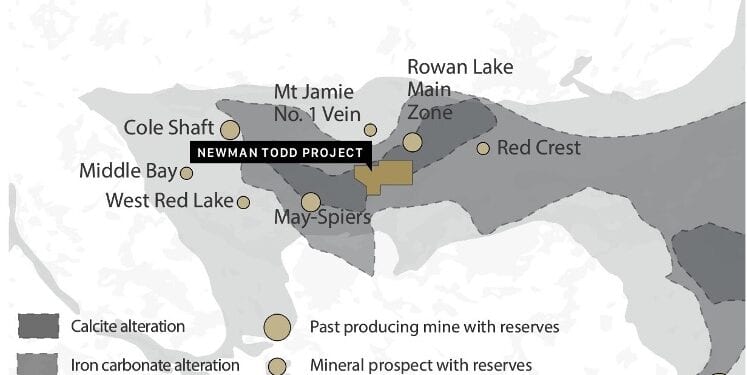Wraps Up 2020 Drilling Programme Results
Trillium Gold Mines Inc.(TSXV: TGM) has continued to expand its flagship Newman Todd Property in Red Lake, Ontario with more high-grade hits contained in the final results from the company’s 2020 drill programme
Vice President of Exploration, Bill Paterson, said results from the final for drill holes of the 2020 drill campaign (NT20-176, NT20-178 to 180 totalling 1,862m) are now complete and compiled. The large backlog of samples at the lab has been rectified and overdue results from our 2021 drilling are now being received. This brings total drilling at Newman Todd in 2020 to 6,081m in 16 drill holes, the first drilling since 2013 on the property.
“Drilling at Newman Todd continues to deliver gold even as we step towards the northern boundary,” Mr Paterson said.
“These results have aided us significantly in our reinterpretation of the structures controlling mineralisation within the NT Zone and have helped with the new modelling, which is directing our current drilling.:
CEO, Russell Starr, said the 2020 drilling can be considered a success in that it has returned significant high-grade gold results as well as validating the company’s understanding of the NT Zone, and has laid the foundation for future drilling to target the structural and veining controls.
“With the geological team possessing over 150 years of Red Lake exploration and development experience, combined with drilling targeting structural and veining controls of the high-grade mineralisation, we are well on the way to delivering a much more robust exploration model that will positively impact the importance of the NT Zone as an open pit amenable deposit.”
Hole NT20-176 was designed to target the central area of the NT Zone, about 100m below the previous high-grade intersection in hole NT20-169 which returned 7.05m of 15.41 g/t gold including 4.30m of 23.88 g/t and 1.12m of 69.85 g/t gold. Hole NT20-176 intersected significant mineralisation of 8.85 g/t Au over 1.0m from 287.5m. The hole also intersected five sections of sulphides, and magnetite ranging from 4m to 18m in core length, as well as narrow quartz veining with galena and pyrite in a section from 308.6-310.9m averaging 0.99 g/t Au over 1.8m.
Hole NT20-178 targeted the NT Zone corridor in the northeast area of the property, looking to expand on previously modelled mineralised sections in the 150-250m downhole interval, and extend mineralization in the 350-400m interval, while testing an iron formation unit in the toe portion of the hole. In the interval from 451-523.5m, the hole intersected sulphide mineralized iron formation breccia and NT Zone silica-carbonate breccia sections on the hanging wall margin of the NT Zone corridor.
This hole is expected to expand historical resources in the upper section of the hole, as the assay results received within the interval from 247–277.5m include 3 intervals with significant composite assay intervals, with a long composite assay of 1.18 g/t Au over 30.5m. In the lower portion of this hole, mineralization was intersected 50-70m below previous results, expanding this zone, with 12 intervals of significant assay composites received, including a long composite from 451-472m that intersected 1.56 g/t Au over 21.07m.
Hole NT20-179 targeted the NT Zone corridor in the northeast area of the property with the hole planned to intersect previously modelled mineralisation from 150-250m and extend mineralisation in the interval from 350-400m. The interval from 436.5-574.23m intersected sulphide-magnetite mineralisation, on the hanging wall margin of the NT Zone corridor. Ten significant composite assay intervals were received in this hole.
Drill hole NT20-180 was designed to target the NT Zone corridor, again, along the northeast boundary of the property, and was planned to intersect previously modelled mineralisation from 50-100m and extend mineralisation in the lower portion of the hole and to infill a 100m wide gap in the drilling.
The hole flattened substantially early on, passing above the planned intersection areas. Drilling was continued to the hanging wall contact of the NT Zone, intersecting multiple 5-10m scale sections of weakly mineralized silica-carbonate breccia NT Zone units alternating with 2-15m sections of felsic tuffs.
Prior drilling on the NT Zone from 2013 and earlier had mostly focused on testing the Zone by targeting the footwall with drilling toward the southeast, now known to be sub-parallel to gold mineralised veining and structures, potentially missing high-grade intersections or undercutting much of the targeted zone.
Mr Starr said Newman Todd is a highly prospective target with 41% of the 165 historic drill holes having intervals of greater than 20 g/t gold over various lengths. In addition, nearly all drilling has been conducted to depths of less than 400 metres.
The Red Lake Camp is famously known for high grade gold mineralisation at depth, with Evolution Mining’s Red Lake Gold Mine currently reaching depths of several thousand feet.
Trillium will continue to test various drill orientations in order to develop a comprehensive understanding of the mineralisation and structural controls and test the depth potential of the Newman Todd Zone.












